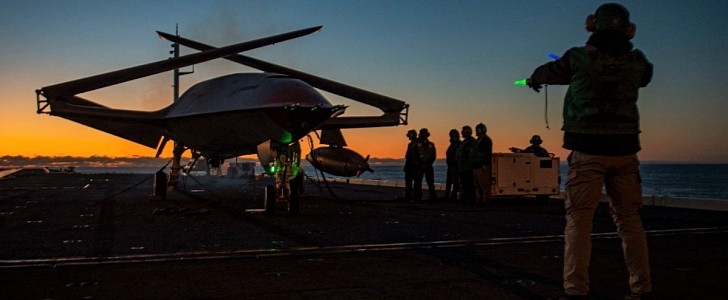The U.S. Navy has recently tested the MQ-25 Stingray’s ability to integrate into carrier-based operations. The demonstration, which took place aboard the USS George H.W. Bush aircraft carrier, included maneuvers such as taxiing, parking on the flight deck, and connecting to the catapult.
In 2019, the government team, along with industry partner Boeing, conducted the first test flight of the MQ-25 test asset, known as T1. Since then, T1 has spent more than 60 hours in the air, helping the team understand more about its aerodynamic performance.
Recently, the U.S. Navy and Boeing conducted a demonstration aboard the USS George H.W. Bush, which allowed the study of the MQ-25 system’s integration into the carrier setting. The team focused specifically on how the ground control system and the aircraft worked together.
The T1 carried out a series of tasks meant to verify the capability of the deck handling system during both day and night operations. The tanker drone taxied on the flight deck, connected to the catapult, and parked as well.
These maneuvers helped the team gather significant data on how the deck’s motion and the wind affect the ability to control the aircraft.
“Our initial look at taxi operations on the flight deck successfully demonstrated the MQ-25’s ability to maneuver just like a manned aircraft in the shipboard environment,” said Captain Chad Reed, Unmanned Carrier Aviation program manager.
Once operational, the MQ-25 Stingray will be piloted from an Unmanned Aviation Warfare Center (UAWC) on aircraft carriers, where the air vehicle operator will carry out a pre-planned mission.
The MQ-25 will be used by the Navy mainly as a carrier-based tanker drone for aerial refueling. It will play a crucial role in increasing the range and capabilities of the carrier air wing (CVW), and it will also pioneer the integration of the manned-unmanned teaming concept. Eventually, the Navy will use the aircraft aboard all of the Nimitz and Ford-class carriers in the future.
Recently, the U.S. Navy and Boeing conducted a demonstration aboard the USS George H.W. Bush, which allowed the study of the MQ-25 system’s integration into the carrier setting. The team focused specifically on how the ground control system and the aircraft worked together.
The T1 carried out a series of tasks meant to verify the capability of the deck handling system during both day and night operations. The tanker drone taxied on the flight deck, connected to the catapult, and parked as well.
These maneuvers helped the team gather significant data on how the deck’s motion and the wind affect the ability to control the aircraft.
“Our initial look at taxi operations on the flight deck successfully demonstrated the MQ-25’s ability to maneuver just like a manned aircraft in the shipboard environment,” said Captain Chad Reed, Unmanned Carrier Aviation program manager.
Once operational, the MQ-25 Stingray will be piloted from an Unmanned Aviation Warfare Center (UAWC) on aircraft carriers, where the air vehicle operator will carry out a pre-planned mission.
The MQ-25 will be used by the Navy mainly as a carrier-based tanker drone for aerial refueling. It will play a crucial role in increasing the range and capabilities of the carrier air wing (CVW), and it will also pioneer the integration of the manned-unmanned teaming concept. Eventually, the Navy will use the aircraft aboard all of the Nimitz and Ford-class carriers in the future.







